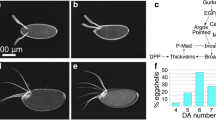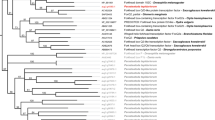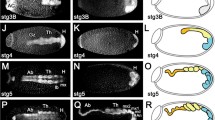Abstract
T-domain transcription factors are involved in many different processes during embryogenesis, such as mesoderm, heart or gut development in vertebrates and in invertebrates. In insects, the following five types of T-box genes are known: brachyenteron (byn), optomotor-blind (omb), optomotor-blind-related-gene-1 (org-1), dorsocross (doc) and H15. As all these classes are present in the genome of the fruit fly Drosophila melanogaster and the flour beetle Tribolium, the multiplicity of the five types of genes varies from dipterans to the beetle. In higher dipterans, a small cluster of three doc genes (doc1–doc3) exists, while the Tribolium genome contains a single Tc-doc gene only. Two H15 genes, Tc-H15a and Tc-H15b, are present in the Tribolium genome compared to a single H15 gene in Drosophila. We have analysed the expression and function of the Tribolium brachyenteron ortholog (Tc-byn). During embryogenesis, Tc-byn is exclusively expressed in the growth zone of the extending germband and later becomes confined to the distal proctodeum and the hindgut, a situation that parallels the expression pattern of byn in Drosophila. Tc-byn-RNAi treated embryos phenocopy Drosophila byn mutants and form no hindgut. In addition, we have characterised a regulatory element upstream of the Tc-byn transcription start site that confers specific gene expression in the developing hindgut of the Drosophila embryo. Our results demonstrate a highly conserved role for Brachyury-type transcriptional regulators in posterior gut development of insects at the level of expression, function and regulation.





Similar content being viewed by others
References
Arendt D, Technau U, Wittbrodt J (2001) Evolution of the bilaterian larval foregut. Nature 409:81–85
Bamshad M, Lin RC, Law DJ, Watkins WC, Krakowiak PA, Moore ME, Franceschini P, Lala R, Holmes LB, Gebuhr TC, Bruneau BG, Schinzel A, Seidman JG, Seidman CE, Jorde LB (1997) Mutations in human TBX3 alter limb, apocrine and genital development in ulnar-mammary syndrome. Nat Genet 16:311–315
Basson CT, Bachinsky DR, Lin RC, Levi T, Elkins JA, Soults J, Grayzel D, Kroumpouzou E, Traill TA, Leblanc-Straceski J, Renault B, Kucherlapati R, Seidman JG, Seidman CE (1997) Mutations in human TBX5 cause limb and cardiac malformation in Holt–Oram syndrome. Nat Genet 15:30–35
Beddington RSP, Rashbass P, Wilson V (1992) Brachyury—a gene affecting mouse gastrulation and early organogenesis. Development Suppl.:157–165
Bucher G, Scholten J, Klingler M (2002) Parental RNAi in Tribolium (Coleoptera). Curr Biol 12:R85–R86
Carmel L, Rogozin IB, Wolf YI, Koonin EV (2007) Patterns of intron gain and conservation in eukaryotic genes. BMC Evol Biol 7:192
Casey ES, O’Reilly MA, Conlon FL, Smith JC (1998) The T-box transcription factor Brachyury regulates expression of eFGF through binding to a non-palindromic response element. Development 125:3887–3894
Clements D, Taylor HC, Herrmann BG, Stott D (1996) Distinct regulatory control of the Brachyury gene in axial and non-axial mesoderm suggests separation of mesoderm lineages early in mouse gastrulation. Mech Dev 56:139–149
Corbo JC, Levine M, Zeller RW (1997) Characterization of a notochord-specific enhancer from the Brachyury promoter region of the ascidian, Ciona intestinalis. Development 124:589–602
Gluecksohn-Schoenheimer S (1944) The development of normal and homozygous Brachy (T/T) mouse embryos in the extraembryonic coelom of the chick. Proc Natl Acad Sci USA 30:134–140
Halpern ME, Ho RK, Walker C, Kimmel CB (1993) Induction of muscle pioneers and floor plate is distinguished by the zebrafish no tail mutation. Cell 75:99–111
Handel K, Basal A, Fan X, Roth S (2005) Tribolium castaneum twist: gastrulation and mesoderm formation in a short-germ beetle. Dev Genes Evol 215:13–31
Herrmann BG, Labeit S, Poustka A, King TR, Lehrach H (1990) Cloning of the T gene required in mesoderm formation in the mouse. Nature 343:617–622
Hinz U, Giebel B, Campos-Ortega JA (1994) The basic–helix–loop–helix domain of Drosophila lethal of scute protein is sufficient for proneural function and activates neurogenic genes. Cell 76:77–87
Holland PW, Koschorz B, Holland LZ, Herrmann BG (1995) Conservation of Brachyury (T) genes in amphioxus and vertebrates: developmental and evolutionary implications. Development 121:4283–4291
Jürgens G, Hartenstein V (1993) The terminal regions of the body pattern. In: Bate M, Martinez Arias A (eds) The development of Drosophila melanogaster. Cold Spring Harbor Laboratory, Long Island, NY, pp 687–746
Jürgens G, Wieschaus E, Nüsslein-Volhard C, Kluding H (1984) Mutations affecting the pattern of the larval cuticle in Drosophila melanogaster. II. Zygotic loci on the third chromosome. Roux’s Arch Dev Biol 193:283–295
Kennerdell JR, Carthew RW (1998) Use of dsRNA-mediated genetic interference to demonstrate that frizzled and frizzled 2 act in the wingless pathway. Cell 95:1017–1026
Kispert A (1995) The Brachyury protein: a T-domain transcription factor. Sem Dev Biol 6:395–403
Kispert A, Herrmann BG (1993) The Brachyury gene encodes a novel DNA binding protein. EMBO J 12:3211–3220
Kispert A, Herrmann BG (1994) Immunohistochemical analysis of the Brachyury protein in wild-type and mutant mouse embryos. Dev Biol 161:179–193
Kispert A, Herrmann BG, Leptin M, Reuter R (1994) Homologs of the mouse Brachyury gene are involved in the specification of posterior terminal structures in Drosophila, Tribolium, and Locusta. Genes Dev 8:2137–2150
Kispert A, Ortner H, Cooke J, Herrmann BG (1995) The Chick Brachyury gene: developmental expression pattern and response to axial induction by localized activin. Dev Biol 168:406–415
Kusch T, Reuter R (1999) Functions for Drosophila brachyenteron and fork head in mesoderm specification and cell signalling. Development 126:3991–4003
Kusch T, Storck T, Walldorf U, Reuter R (2002) Brachyury proteins regulate target genes through modular binding sites in a cooperative fashion. Genes Dev 16:518–529
Li QY, Newbury-Ecob RA, Terrett JA, Wilson DI, Curtis AR, Yi CH, Gebuhr T, Bullen PJ, Robson SC, Strachan T, Bonnet D, Lyonnet S, Young ID, Raeburn JA, Buckler AJ, Law DJ, Brook JD (1997) Holt–Oram syndrome is caused by mutations in TBX5, a member of the Brachyury (T) gene family. Nat Genet 15:21–29
Murakami R, Shigenaga A, Kawakita M, Takimoto K, Yamaoka I, Akasaka K, Shimada H (1995) aproctous, a locus that is necessary for the development of the proctodeum in Drosophila embryos, encodes a homolog of the vertebrate Brachyury gene. Roux’s Arch Dev Biol 205:89–96
Naiche LA, Harrelson Z, Kelly RG, Papaioannou VE (2005) T-box genes in vertebrate development. Annu Rev Genet 39:219–239
O’Reilly MA, Smith JC, Cunliffe V (1995) Patterning of the mesoderm in Xenopus: dose-dependent and synergistic effects of Brachyury and Pintallavis. Development 121:1351–1359
Rehorn K-P, Thelen H, Michelson AM, Reuter R (1996) A molecular aspect of hematopoiesis and endoderm development common to vertebrates and Drosophila. Development 122:4023–4031
Reuter R (1994) The gene serpent has homeotic properties and specifies endoder versus ectoderm within the Drosophila gut. Development 120:1123–1135
Rogozin IB, Wolf YI, Sorokin AV, Mirkin BG, Koonin EV (2003) Remarkable interkingdom conservation of intron positions and massive, lineage-specific intron loss and gain in eukaryotic evolution. Curr Biol 13:1512–1517
Sander K (1976) Specification of the basic body pattern in insect embryogenesis. Adv Insect Physiol 12:125–238
Satoh G, Harada Y, Satoh N (2000) The expression of nonchordate deuterostome Brachyury genes in the ascidian Ciona embryo can promote the differentiation of extra notochord cells. Mech Dev 96:155–163
Schröder R, Eckert C, Wolff C, Tautz D (2000) Conserved and divergent aspects of terminal patterning in the beetle Tribolium castaneum. Proc Natl Acad Sci USA 97:6591–6596
Schulte-Merker S, van Eeden FJ, Halpern ME, Kimmel CB, Nüsslein-Volhard C (1994) no tail (ntl) is the zebrafish homologue of the mouse T (Brachyury) gene. Development 120:1009–1015
Shinmyo Y, Mito T, Uda T, Nakamura T, Miyawaki K, Ohuchi H, Noji S (2006) brachyenteron is necessary for morphogenesis of the posterior gut but not for anteroposterior axial elongation from the posterior growth zone in the intermediate-germband cricket Gryllus bimaculatus. Development 133:4539–4547
Shoguchi E, Satoh N, Maruyama YK (1999) Pattern of Brachyury gene expression in starfish embryos resembles that of hemichordate embryos but not of sea urchin embryos. Mech Dev 82:185–189
Singer JB, Harbecke R, Kusch T, Reuter R, Lengyel JA (1996) Drosophila brachyenteron regulates gene activity and morphogenesis in the gut. Development 122:3707–3718
Smith J (1997) Brachyury and the T-box genes. Curr Opin Genet Dev 7:474–480
Smith JC, Price BM, Green JB, Weigel D, Herrmann BG (1991) Expression of a Xenopus homolog of Brachyury (T) is an immediate-early response to mesoderm induction. Cell 67:79–87
Sokoloff A (ed.) (1972) Developmental and post-embryonic studies. In: The biology of Tribolium. Clarendon, Oxford, pp 163–206
Sommer RJ, Tautz D (1993) Involvement of an orthologue of the Drosophila pair-rule gene hairy in segment formation of the short germ-band embryo of Tribolium (Coleoptera). Nature 361:448–450
Spradling AC (1986) P element-mediated transformation. In: Roberts D (ed) Drosophila, a practical approach. IRL, Oxford
Strimmer K, von Haeseler A (1996) Quartet puzzling: a quartet maximum likelihood method for reconstructing tree topologies. Mol Biol Evol 13:964–969
Tada M, Casey ES, Fairclough L, Smith JC (1998) Bix1, a direct target of Xenopus T-box genes, causes formation of ventral mesoderm and endoderm. Development 125:3997–4006
Tautz D, Pfeifle C (1989) A non-radioactive in situ hybridization method for the localization of specific RNAs in Drosophila embryos reveals translational control of the segmentation gene hunchback. Chromosoma 98:81–85
The Tribolium Genome Sequencing Consortium (2008) The genome of the developmental model beetle and pest Tribolium castaneum. Nature (in press)
Thummel CS, Boulet AM, Lipshitz HD (1988) Vectors for Drosophila P-element-mediated transformation and tissue culture transfection. Gene 74:445–450
Wattler S, Russ A, Evans M, Nehls M (1998) A combined analysis of genomic and primary protein structure defines the phylogenetic relationship of new members if the T-box family. Genomics 48:24–33
Weigel D, Jürgens G, Kuettner F, Seifert E, Jäckle H (1989) The homeotic gene fork head encodes a nuclear protein and is expressed in the terminal regions of the Drosophila embryo. Cell 57:645–658
Wilkinson DG, Bhatt S, Herrmann BG (1990) Expression pattern of the mouse T gene and its role in mesoderm formation. Nature 343:617–622
Wilson V, Manson L, Skarnes WC, Beddington RSP (1995) The T gene is necessary for normal mesodermal morphogenetic cell movements during gastrulation. Development 121:877–886
Yamaguchi TP, Takada S, Yoshikawa Y, Wu N, McMahon AP (1999) T (Brachyury) is a direct target of Wnt3a during paraxial mesoderm specification. Genes Dev 13:3185–3190
Acknowledgements
We would like to thank E. Müller and T. Mader for expert technical assistance and are grateful to A. Beermann and A. Robinson for discussions and other input. This work was supported by a grant of the Deutsche Forschungsgemeinschaft (RE 1139-3).
Author information
Authors and Affiliations
Corresponding author
Additional information
Communicated by S. Roth
Rights and permissions
About this article
Cite this article
Berns, N., Kusch, T., Schröder, R. et al. Expression, function and regulation of Brachyenteron in the short germband insect Tribolium castaneum . Dev Genes Evol 218, 169–179 (2008). https://doi.org/10.1007/s00427-008-0210-7
Received:
Accepted:
Published:
Issue Date:
DOI: https://doi.org/10.1007/s00427-008-0210-7




